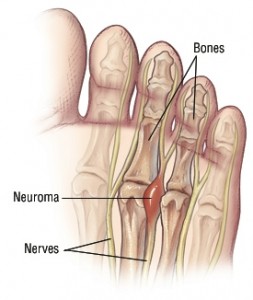WHAT IS A MORTON’S NEUROMA?
 A Morton’s Neuroma is a swelling or scarring of a nerve that runs between the 3rd and 4th toes. The nerve functions to provide sensation to the toes. The symptoms include pain or numbness to the toes and can present depending on activity level and also shoe gear. A neuroma is sometimes described as a tumor, but it is not a cancer and will not affect any other part of your body. The symptoms of a neuroma begin with pain or numbness. Additional symptoms include burning and tingling in the toes and many of these symptoms are elicited when walking and wearing tight shoes. Often, as the process worsens, the patient will feel shooting electrical pain in the foot, even when you are nonactive.
A Morton’s Neuroma is a swelling or scarring of a nerve that runs between the 3rd and 4th toes. The nerve functions to provide sensation to the toes. The symptoms include pain or numbness to the toes and can present depending on activity level and also shoe gear. A neuroma is sometimes described as a tumor, but it is not a cancer and will not affect any other part of your body. The symptoms of a neuroma begin with pain or numbness. Additional symptoms include burning and tingling in the toes and many of these symptoms are elicited when walking and wearing tight shoes. Often, as the process worsens, the patient will feel shooting electrical pain in the foot, even when you are nonactive.
HOW IS A MORTON’S NEUROMA DIAGNOSED?
The diagnoses of a Morton’s neuroma can be made with a thorough history of the symptoms and focused physical exam. As part of the physical exam we will squeeze the area of the foot just before your toes. If the neuroma mass is present a click with be felt by you and the doctor. This exam might elicit the pain as well. This exam is called a Mulder’s Sign.
Diagnostic tests can be performed to confirm the mass is present and to identify the etiology of the mass. An X-ray can show if the long bones in your foot are too close to one another which is causing the irritation and enlargement of the nerve. An MRI or ultrasound of the foot can help identify and locate the mass.
WHY DO I HAVE A MORTON’S NEUROMA?
To understand this process, we must review the anatomy of the foot. The nerve that is generally in question is called an intermetatarsal nerve. This nerve starts at about the midfoot and runs between the metatarsals or the long bones that are located behind your toes. As the nerve continues to the toes, it dives beneath a band of tissue that holds the head of the metatarsals together. As it passes that band, the nerve splits into two nerves and provides sensation to the outside half of the 3rd and inside half of the 4th toe. Or to word it differently, the nerve provides sensory innervation to the space between the 3rd and 4th toes, including half of each of the toes.
The neuroma develops just beneath or about the area of the band of tissue that holds the metatarsal heads together. The constant rubbing of the band of tissue and irritation from the metatarsal heads begins to scar the nerve. This begins to send a signal back to the brain that there is something wrong and after continual irritation the signs and symptoms we discussed earlier will arise. High heeled shoes, tight shoes, and increased body weight can also aggravate the process.
HOW CAN I TREAT THIS PROBLEM?
Changing your shoe gear to flatter and wider shoes can help. Also resting the foot can help. Nonsteriodal anti-inflammatory medication like advil and alleve can proved further relief.
WHAT WILL MY DOCTOR DO FOR THIS PROBLEM?
After attempting home treatments, please seek the care of our doctors. After the diagnosis is made, we can attempt many ways to treat this problem conservatively without the need for surgery. We have the most current techniques to treating this problem. The latest technique for treating a Morton’s neuroma is the use of a sclerosing agent in an injection. After 4 to 7 treatments, most individuals get the benefit of complete resolution of symptoms. This with the use of custom orthotics (shoe inserts) and alteration in shoe gear will help maintain resolution of symptoms.
We also now offer laser treatment for neuromas. This laser therapy is safe and has FDA clearance, is painless, side-effect free, and proven to be effective. For more information about our ground-breakering laser treatment, click here.
If these treatments are unsuccessful surgery is the ultimate option. We utilize the latest techniques in surgery. This can include a minimally invasive technique to release the band of tissue that is irritating the nerve or complete removal of the nerve. The decision on the type of procedure is case dependant and will depend on the patient.
CAN I PREVENT THIS FROM HAPPENING AGAIN?
Shoe gear alterations including flatter and wider shoes are the key step. Next using custom orthotics in the shoes will help reoccurrence. Maintaining well repaired shoes and orthotics will further help reoccurrence. If your pain does return, seek our care immediately. Treatment of acute pain rather than chronic pain is easier.

